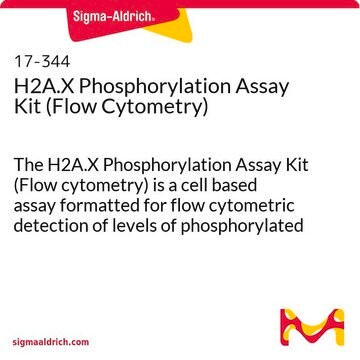16-202A
Anti-phospho-Histone H2A.X (Ser139) Antibody, clone JBW301, FITC conjugate
clone JBW301, Upstate®, from mouse
Synonym(s):
H2AXS139P, Histone H2A.X (phospho S139), H2A histone family, member X, H2AX histone
About This Item
Recommended Products
biological source
mouse
Quality Level
conjugate
FITC conjugate
antibody form
purified immunoglobulin
antibody product type
primary antibodies
clone
JBW301, monoclonal
species reactivity
human
manufacturer/tradename
Upstate®
technique(s)
flow cytometry: suitable
immunocytochemistry: suitable
isotype
IgG1
NCBI accession no.
UniProt accession no.
shipped in
dry ice
target post-translational modification
phosphorylation (pSer139)
Gene Information
human ... H2AX(3014)
General description
Specificity
Immunogen
Application
Epigenetics & Nuclear Function
Histones
Quality
Flow Cytometry: Log phase Jurkat cells were treated with staurosporine (1 μg/mL) for the indicated time. Histone H2A.X (Ser 139) phosphorylation was detected as described in the manual for the H2A.X Phosphorylation Assay Kit (Flow Cytometry), Catalog # 17-344. Cells were analyzed on a Becton-Dickinson FACS-Calibur flow cytometer.
Target description
Physical form
Storage and Stability
Analysis Note
Staurosporine-treated Jurkat cells
Other Notes
Legal Information
Disclaimer
Not finding the right product?
Try our Product Selector Tool.
Storage Class Code
12 - Non Combustible Liquids
WGK
WGK 2
Flash Point(F)
Not applicable
Flash Point(C)
Not applicable
Certificates of Analysis (COA)
Search for Certificates of Analysis (COA) by entering the products Lot/Batch Number. Lot and Batch Numbers can be found on a product’s label following the words ‘Lot’ or ‘Batch’.
Already Own This Product?
Find documentation for the products that you have recently purchased in the Document Library.
Articles
Flow cytometry dye selection tips match fluorophores to flow cytometer configurations, enhancing panel performance.
Troubleshooting guide offers solutions for common flow cytometry problems, ensuring improved analysis performance.
Protocols
Learn key steps in flow cytometry protocols to make your next flow cytometry experiment run with ease.
Explore our flow cytometry guide to uncover flow cytometry basics, traditional flow cytometer components, key flow cytometry protocol steps, and proper controls.
Our team of scientists has experience in all areas of research including Life Science, Material Science, Chemical Synthesis, Chromatography, Analytical and many others.
Contact Technical Service







